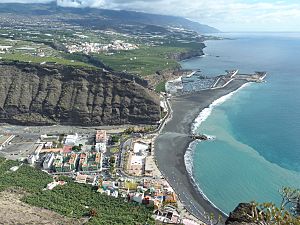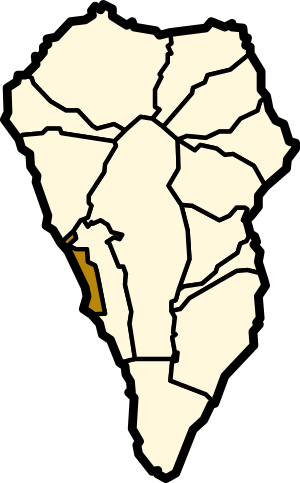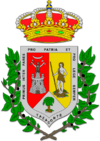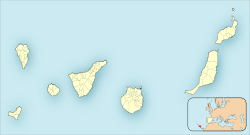Tazacorte facts for kids
Quick facts for kids
Tazacorte
|
|||
|---|---|---|---|

The port of Tazacorte
|
|||
|
|||

Location in La Palma
|
|||
| Country | Spain | ||
| Autonomous community | Canary Islands | ||
| Province | Tenerife | ||
| Island | La Palma | ||
| Area | |||
| • Total | 11.37 km2 (4.39 sq mi) | ||
| Elevation | 132 m (433 ft) | ||
| Population
(2018)
|
|||
| • Total | 4,600 | ||
| • Density | 405/km2 (1,048/sq mi) | ||
Tazacorte is a town and a municipality on the island of La Palma. This island is part of the Canary Islands in Spain. Tazacorte is located near the coast, on the western side of La Palma. In 2018, about 4,600 people lived there. The area of the municipality is 11.37 square kilometers. The town is about 60 meters above sea level.
Tazacorte is 2 kilometers southwest of Los Llanos de Aridane. It is also 17 kilometers west of the island's capital, Santa Cruz de La Palma. The people who live in Tazacorte are called Bagañetes. Most of the land in Tazacorte, about 85%, is used for farming. Farmers mainly grow bananas here.
Contents
History of Tazacorte
The story of Tazacorte began a long time ago. On September 29, 1492, Alonso Fernández de Lugo started to conquer La Palma. He landed at the mouth of the Las Angustias ravine, which is where the Port of Tazacorte is today. There was no fighting when he landed. This allowed a peaceful settlement in the flat area of Tazacorte.
This area became the site of the first camp. A small church, called the chapel of San Miguel, was built there. San Miguel became the patron saint of Tazacorte and the entire island of La Palma.
Early Days and Sugar Cane
Over time, the fertile land of Tazacorte was sold many times. In 1513, a man from Flanders named Jacome Groenenberg bought the Hacienda of Tazacorte. He changed his name to Jácome Monteverde. From then on, the land was used to grow sugar cane. This was done in a system similar to how things were run in old castles, with workers tied to the land.
The Port of Tazacorte was the second most important port on La Palma. It was busy after the main port in the capital city. Since the 1500s, ships from Spain and other countries stopped here. They exported sugar cane, wine, and other local products. By the late 1700s, many farmers in Tazacorte were very poor. They did not have many belongings and were often hungry. Their main food was fern roots.
In August 1812, the municipality of Los Llanos was created. It included Los Llanos, El Paso, Argual, and Tazacorte. Around 1815, sugar cane became less profitable. The plant needed a lot from the soil, and the land in the region was getting tired. By 1830, the last sugar mill in Tazacorte closed. People then started growing crops for themselves. However, after 1850, Tazacorte found new ways to make money. Fishing and growing cochineal (a type of insect used for dye) became important. These activities brought wealth to some and helped others survive.
From 1890 onwards, growing tomatoes and then bananas became very popular. These crops were added to the shipments of tobacco, sugar, and cochineal that were still sent to other countries.
Tazacorte in the 20th Century
After World War I ended, European markets opened up again for bananas and tomatoes. In 1919, a British company called Fyffes Limited started renting farms in Tazacorte. They improved banana plantations and sold more bananas at better prices. By the mid-1920s, about 70% of the people in Tazacorte worked in the banana export business.
By 1923, Tazacorte was the most populated area in the municipality of Los Llanos. It had 2,316 residents. It was also the most developed area in the Aridane Valley, which is a nearby region.
A Brief Independence Bid
In 1925, something very unusual happened. For three days, the people of Tazacorte declared themselves an independent country from Spain! They even wrote a poem about it: "With hooks, sticks, and canes / let's shout with a loud voice / Long live free Tazacorte / and independent of Spain." During these three days, they used their hunting guns to stop anyone from crossing their borders.
However, their independence did not last long. A Spanish warship arrived and fired a large cannonball. It flew over Tazacorte and landed on a nearby mountain. Even though the mountain was part of a "foreign country" (as they saw it), it was very close to their "capital." This made them surrender.
Even though they didn't become independent from Spain, they did achieve something else important that year. On September 16, 1925, the government allowed Tazacorte to become independent from the municipality of Los Llanos. This meant Tazacorte became its own separate town. The first mayor of Tazacorte was Miguel Medina Quesada, a teacher.
In August 1926, there was a health concern in Tazacorte. A plague epidemic affected many people.
Political Changes and Growth
On April 14, 1931, after local elections, King Alfonso XIII left Spain. The Second Republic was declared. In Tazacorte, people who supported liberal ideas and the republic celebrated in the streets. This began a time of strong political activity in the town.
With democracy, ordinary people started to get more involved in politics. This led to a big growth in labor unions in Tazacorte. Communism also became very popular. In 1931, a union called Sindicato Oficios Varios was restarted. In just three years, 800 workers and small farmers in Tazacorte joined it.
In 1932, the Workers' and Peasants' Group was formed. This group had communist ideas. They won the local elections in 1933 by a large majority, getting six council members. In the general elections of 1936, they received 72.2% of the votes for the Popular Front.
In August 1931, a newspaper called Tribuna started. The next year, it changed its name to Tribuna Libre. This newspaper was published until 1935. It was led by Miguel Ángel Rodríguez García, a journalist who had returned from Argentina.
On July 17 and 18, 1936, there was a military uprising against the government. News of this reached Tazacorte on the morning of July 18. The mayor at the time, Francisco Pulido, handed over control to a group supported by the Oficios Varios Union. This group called for a general strike. Workers completely stopped working in the town. They only continued with irrigation to make sure the crops did not die.
In 1979, the first local elections of the new democracy were held. The Communist Party won these elections in Tazacorte.
People of Tazacorte
This section shows how the number of people living in Tazacorte has changed over the years.
Population Numbers
| Year | Population |
|---|---|
| 1991 | 6,502 |
| 1996 | 6,909 |
| 2001 | 5,062 |
| 2002 | 6,108 |
| 2003 | 6,107 |
| 2004 | 5,797 |
| 2013 | 4,911 |
| 2014 | 4,620 |
Where People Live
This table breaks down the population by different areas within Tazacorte. The numbers are from 2014 and show how many men and women live in each area.
| Nucleus | Residents (2014) | Men | Women |
|---|---|---|---|
| Cardón | 85 | 44 | 41 |
| La Costa | 464 | 234 | 230 |
| Marina | 300 | 144 | 156 |
| Puerto | 1187 | 607 | 580 |
| San Borondón | 266 | 135 | 131 |
| Tarajal | 27 | 13 | 14 |
| Tazacorte | 2515 | 1274 | 1241 |
See also
 In Spanish: Tazacorte para niños
In Spanish: Tazacorte para niños





